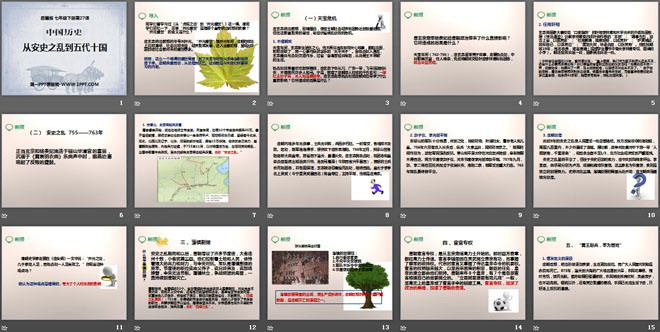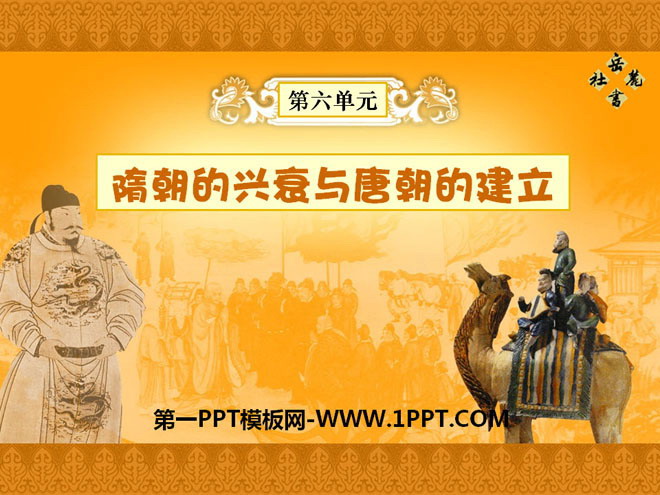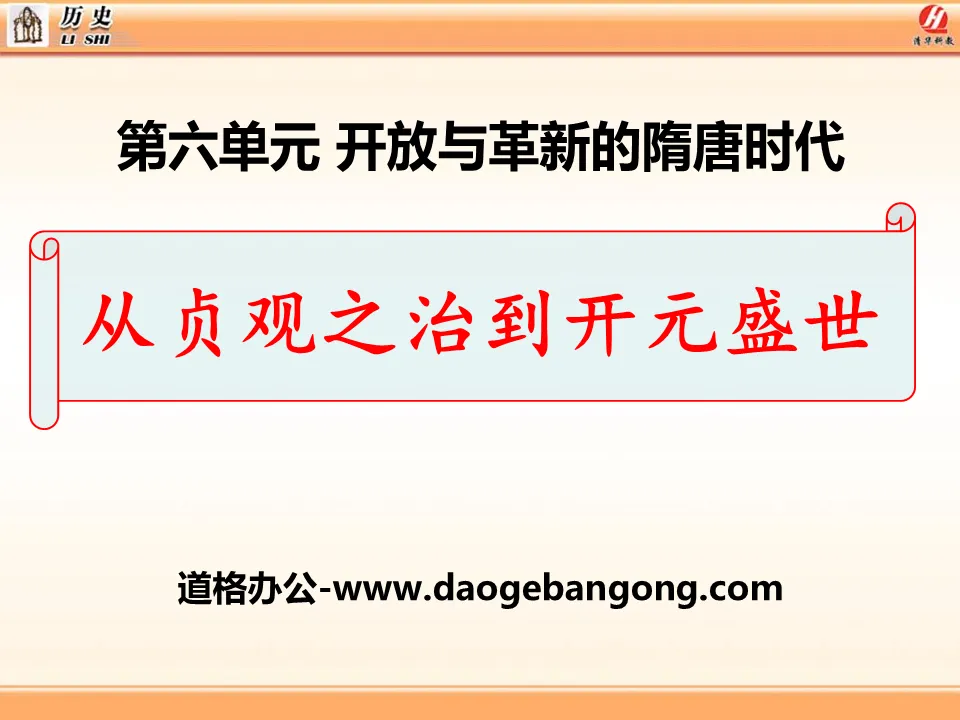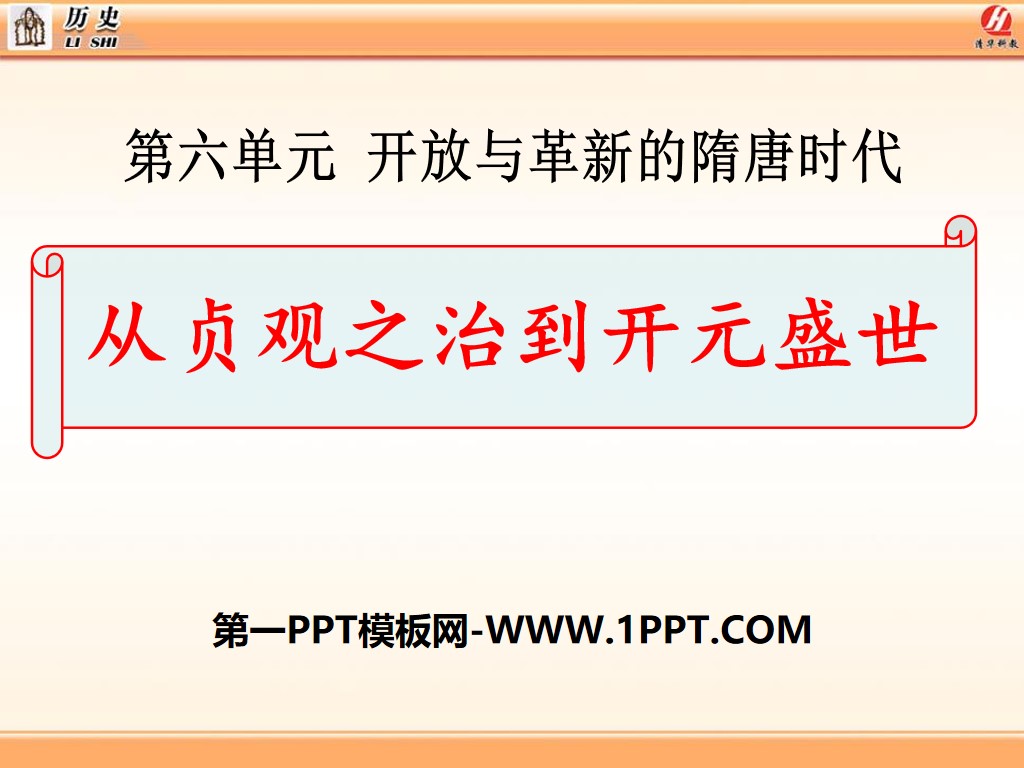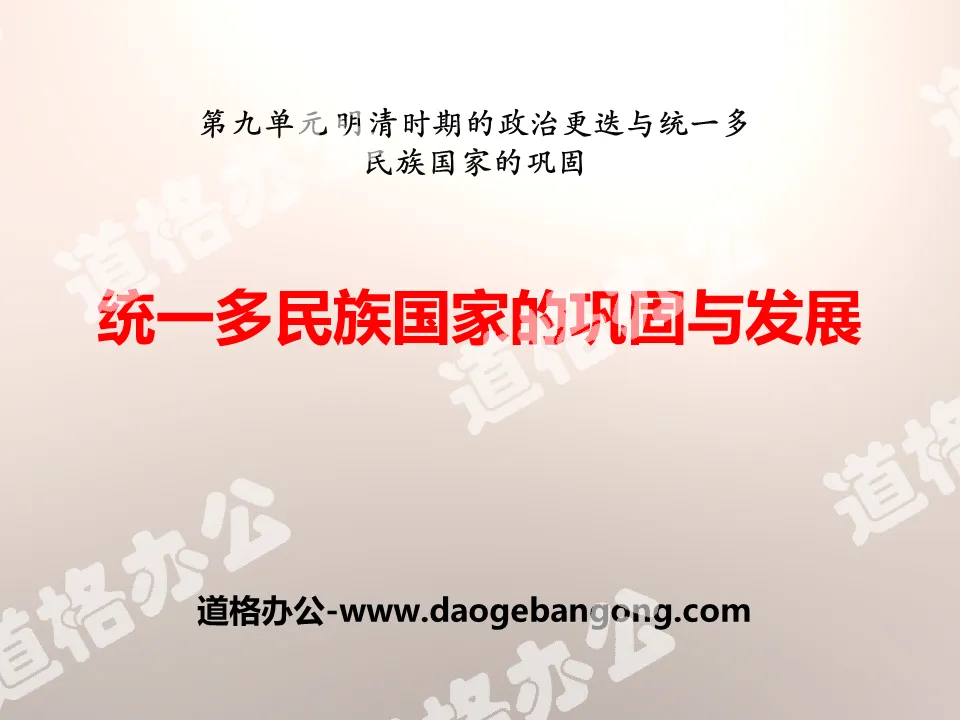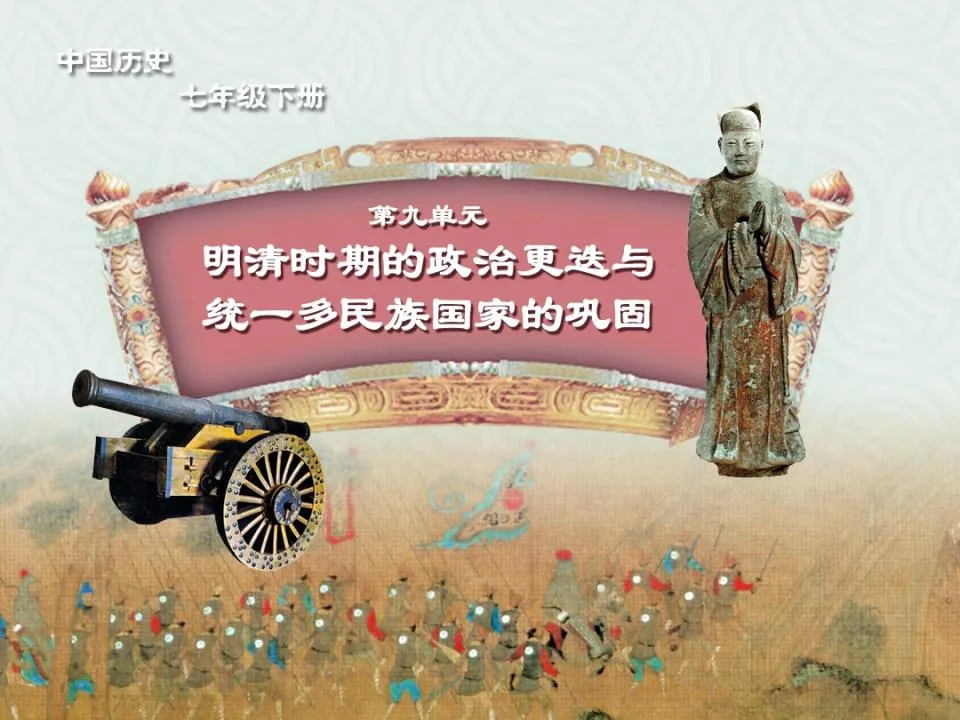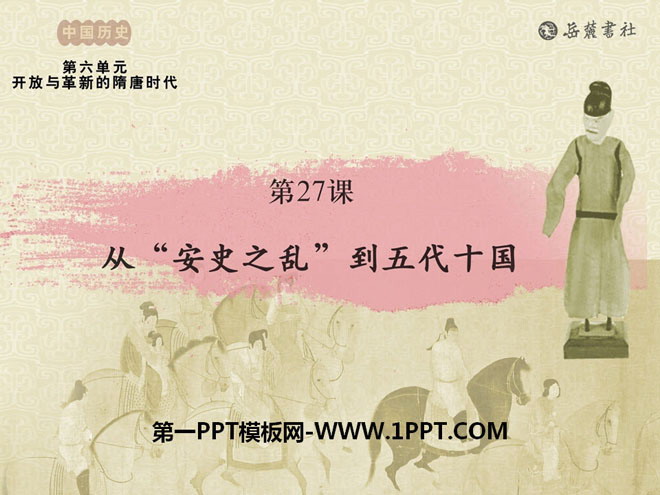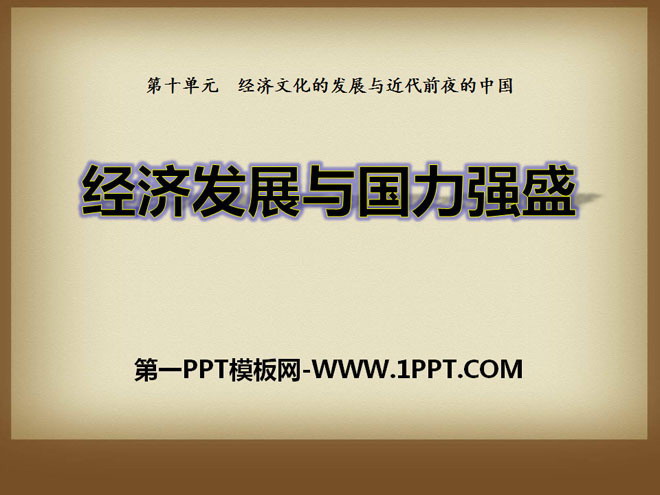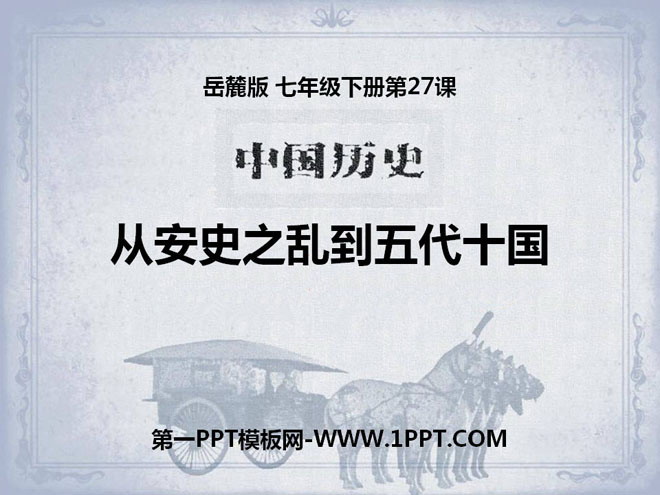
| Category | Format | Size |
|---|---|---|
| Yuelu Edition Seventh Grade History Volume 2 | pptx | 6 MB |
Description
"From the An-Shi Rebellion to the Five Dynasties and Ten Kingdoms" PPT courseware of openness and innovation in the Sui and Tang Dynasties 3
import
The students have studied the lesson "From the "Reign of Zhenguan" to the "Prosperous Age of Kaiyuan". Ask the students to recall and answer the historical events of which emperor's reign does "Kaiyuan Heyday" refer to? What is the meaning of "Kaiyuan prosperous age"?
The reign of Emperor Xuanzong of the Tang Dynasty was called Kaiyuan. "Kaiyuan prosperous age" refers to the Kaiyuan period, when the Tang Dynasty was relatively clear politically, relatively stable socially, prosperous and developed economically, and entered its heyday, presenting an unprecedented prosperous scene for Chinese feudal society.
However, such a rare prosperous situation fell sharply from its peak during the Tianbao period. The Tang Dynasty went from prosperity to decline, from decline to destruction. These are what we are going to learn today.
(1) Tianbao Crisis
In the early period of Tang Xuanzong's reign, he worked hard to govern, bringing the Tang Dynasty's social economy and national power to its peak. But behind this wealth and prosperity, there is a crisis of chaos and decline.
1. Ignore government affairs
During the Tianbao period, Xuanzong gradually became arrogant and extravagant. He no longer cares about political affairs, manages the country diligently, and is enterprising as he did in the past, but he only wants to be the "Emperor of Peace" who indulges in pleasure. After Yang Guifei entered the palace, Xuanzong drank and had fun with the imperial concubine all day long, living a life of "the spring night is short and the days are high, and the king does not go to court early from now on".
Concubine Yang liked to eat fresh lychees very much. Emperor Xuanzong of the Tang Dynasty ordered that Pegasus be transported from Sichuan and Guangdong to Chang'an, even if many people and horses were killed. Thus, there is a famous saying by Tang Dynasty poet Du Mu: When a concubine rides on the red dust, she laughs, but no one knows that it is a lychee. What direct impact did Tang Xuanzong's favor on Concubine Yang bring to the politics of the Tang Dynasty? What are its consequences?
2. Appointment of traitors
Xuanzong left state affairs to the treacherous prime minister Li Linfu, who was "a secretive man" and a treacherous relative Yang Guozhong. According to "Zi Zhi Tong Jian", Li Linfu had four "skills" for doing evil: "To influence people with flattery, to cater to others". "I want to protect my favor"; "Ignore the way of speech and conceal my wisdom to make him a traitor"; "I am jealous of the virtuous and capable, and suppress my superiors in order to protect my position"; "Repeat big jails and execute noble ministers" , to expand its momentum." He monopolized the government for 19 years, killing loyal people and blocking the way of speech (remind students to read the small print in the book about Li Linfu's dictatorship and obstruction of remonstrance). The corruption in the imperial court is getting worse day by day, and the country is facing disaster every day.
(Li Linfu served as prime minister for 19 years. He once said to his admonishers: "Your Majesty, it's too late for us as ministers to obey, so why do we need to talk so loudly? Haven't you seen the ceremonial horses in front of the palace? If you don't say a word all day long, , you will be full; if you bark, you will be driven away immediately, and it will be too late not to scream in the future." Because of his suppression, it was difficult for Emperor Xuanzong of the Tang Dynasty to hear any good advice. Yang Guozhong was originally a scoundrel in the market. Cousin Yang Guifei is the prime minister. He holds more than 40 positions, giving orders at will and handling political affairs indiscriminately.)
(2) Anshi Rebellion 755-763
1. An Lushan and Shi Siming rebelled against the Tang Dynasty
Starting from Ruizong in the Tang Dynasty, Jiedushi envoys were established in the border areas. During the Tianbao period, the 10 border envoys had a total of 490,000 troops. An Lushan, who was good at flattering and flattering and won Xuanzong's trust, took charge of the three towns of Pinglu, Fanyang and Hedong. He governed today's Beijing, Hebei, Shanxi and parts of Liaoning, Shandong and Henan, and had 150,000 cavalry. Relying on his own power, he took advantage of the political corruption of the Tang Dynasty and the lack of military strength in the interior. In November 755, in the name of challenging Yang Guozhong, he launched a rebellion in Fan Yang in an attempt to seize the central power of the Tang Dynasty. Later, his general Shi Siming also raised troops to rebel against the Tang Dynasty. It is known in history as the "Anshi Rebellion."
2. Guo Ziyi and Li Guangbi suppressed the rebellion
An Lushan's army was very brutal. Wherever they went, they robbed property, raped women, and massacred the elderly and children. After they invaded Chang'an in June 756, they sent troops to "defeat the people for three days and plunder all the people's property." The rebels' misbehavior aroused strong resistance from the army and the people. The governors of Changshan and Pingyuan raised troops in Hebei to resist the enemy and restrain the rebels from advancing westward. Guo Ziyi, the governor of Shuofang, and Li Guangbi, the governor of Hedong, led their troops to put down the rebellion. In September 757, generals Guo and Li, with the cooperation of Uighur soldiers, recaptured Chang'an and Luoyang, and the rebels suffered a major blow. The rebellion was finally put down in 763.
3. The decline of the Tang Dynasty
The Anshi Rebellion, which lasted for eight years, caused an unprecedented upheaval to the people. Luoyang City was repeatedly captured by both sides, and many prefectures and counties within hundreds of miles were in ruins. According to records, the area in the middle and lower reaches of the Yellow River affected by the war was "depopulated and thousands of miles of depression". Less than 1/3 of the people survived the disaster, and the social economy of the north was severely devastated.
Although the Anshi Rebellion subsided, due to the strength of the old Anshi Rebellion, the Central Committee of the Tang Dynasty made Li Huaixian, Li Baochen, and Tian Chengsi the envoys of Lu Long, Chengde, and Wei Bo respectively. These three families are called Jiedushi, but they are actually independent separatist forces. Historically known as the Three Towns of Hebei Province. From then on, the separatist situation of vassal towns began, and the Tang Dynasty turned from strength to decline.
3. Separation of vassal towns
What is the Fanzhen separatist regime?
During and after the Anshi Rebellion, the Tang Dynasty added many Jiedushi envoys, the larger ones were as many as ten in Lianzhou, and the smaller ones were as many as three or four. They control the land and people, and rely on their powerful military and financial resources to confront the central government. The army is the capital of the feudal system. The position of Jiedushi may be passed down from father to son, or from elder brother to younger brother, or by subordinate generals, and the central government cannot control it. There were many vassal towns and frequent wars, which lasted until the fall of the Tang Dynasty.
In the late Tang Dynasty, there were nearly 50 vassal towns. The governors of some vassal towns appeared to respect the imperial court, but in fact they were completely unrestrained. They did not submit taxes to the central government and had their own regulations and laws. Even after the death of some Jiedu envoys, they were directly succeeded by their sons, or were appointed by subordinates. The court could only appoint them afterwards and could not change them. (Reason for the Rebellion of the Four Towns): In 781, after the death of Li Baochen, the Jiedushi envoy of Chengde Town, his son inherited the position of Jiedushi and asked the court to replace him. Tang Dezong firmly refused. Li Weiyue united with the Jiedu envoys of the other three towns and launched a cavalry rebellion against the Tang Dynasty, which was known as the "Rebellion of the Four Towns" in history.
4. The exclusive power of eunuchs
The exclusive power of eunuchs in the Tang Dynasty began when Xuanzong favored Gao Lishi. At that time, memorials from all directions were delivered by Gao Lishi. The eunuch Li Fuguo took command of the imperial army because of his meritorious service in supporting Suzong in Lingwu. During the reign of Emperor Daizong, the eunuchs again had the confidential power to convey the emperor's orders. The power of the eunuchs became more and more powerful, and they later controlled the formulation of national policies, the appointment and dismissal of courtiers, and the dismissal and establishment of emperors. There were eight emperors in the late Tang Dynasty, seven of whom were supported by eunuchs of various factions based on their own needs. "It's child's play to establish a king, kill a king, and depose a king." The supreme emperor became a taming tool in the hands of eunuchs. The exclusive power of eunuchs deepened the political darkness and accelerated the decline of the Tang Dynasty.
5. "The Yellow King raised his army for the common people."
1. Reasons for the uprising
In the late Tang Dynasty, the ruling class became more greedy and their life became more decadent. But what the majority of the people are facing is abject poverty and death. In 873, the vast area from Tongguan to Dahai encountered a severe drought. Farmers ate grass roots and locust leaves to satisfy their hunger, and countless people died of starvation. However, the government continued to press for taxes, and farmers were forced to demolish their houses, cut down trees, and sell their wives and children, but they could not pay the taxes. In addition to taxes, there are other heavy errands. The peasants could no longer survive and had no choice but to embark on the road of resistance.
2. Wang Xianzhi and Huang Chao launched an uprising in 875
In early 875, Wang Xianzhi led thousands of people to revolt in Changyuan (now Changyuan, Henan), and Huang Chao also gathered people to respond. They used flexible tactics to connect the prefectures and counties, and galloped between the Yangtze River, the Huaihe River, and the Han Dynasty. In 878, Wang Xianzhi died in battle in Huangmei, Hubei Province. Everyone publicly elected Huang Chao as the king, known as the "Great General Soaring to the Sky".
3. Mobile warfare and the Daqi regime
In order to effectively attack the enemy and develop revolutionary forces, the rebel army turned to attack Jiangnan, which was weakly defended and was the main supplier of wealth to the Tang Dynasty. Huang Chao led his army to cross the river in Hezhou, Anhui, and successively invaded Zhejiang, Fujian, and Guangzhou in the summer of 879. By this time, the rebel army had grown to more than 500,000 people. Due to the rich combat experience accumulated through many years of campaign, the time is ripe to expand the results of victory. In Guangzhou, Huang Chao issued a proclamation, denounced the courtiers and eunuchs for collaborating and corrupting discipline. Announced that he would go straight to Chang'an and overthrow the Li Tang Dynasty. In October, the massive Northern Expedition began. First they conquered Guizhou (now Guilin), then broke through Tanzhou (now Changsha) along the Xiang River, passed through Hunan and entered Hubei, followed the Yangtze River eastward, and attacked today's Jiangxi, southern Anhui, and western Zhejiang. He also crossed the Yangtze River from Anhui to the north, descended to Luoyang and reached Tongguan without fighting. On January 8, 881, Tang Xizong fled Chang'an in a hurry. On the same day, Huang Chao, the leader of the rebel army, rode a gold-decorated carriage and led thousands of troops into Chang'an. The people of Chang'an flocked to the streets to welcome him. On January 16, the peasant army held a grand founding ceremony in Chang'an, and the country was named Daqi.
Six, Five Dynasties and Ten Kingdoms
In the more than 50 years after the fall of the Tang Dynasty, three dynasties emerged in the Central Plains: the Later Liang, the Later Tang, the Later Jin, the Later Han, and the Later Five dynasties, collectively known as the "Five Dynasties". At the same time as the Five Dynasties, a number of small independent states were established in the south and Shanxi areas, collectively known as the "Ten Kingdoms".
The Five Dynasties and Ten Kingdoms, including many separatist regimes such as the Five Dynasties and the Ten Kingdoms, is a period in Chinese history that began with the fall of the Tang Dynasty and ended with the establishment of the Song Dynasty; it can also be defined as the period until the Song Dynasty unified the remaining political powers of the Ten Kingdoms.
Read the text carefully and think about it, what is the connection between the emergence of the Five Dynasties and Ten Kingdoms and the separatist rule of feudal towns?
The Tang Dynasty prospered for a while and then declined. The material abundance made the nobles live a luxurious life. Politics gradually became corrupt. The military was weakened to whitewash peace. The gap between the rich and the poor intensified and class conflicts intensified. It triggered rebellions and uprisings among the poor. Later rulers of the court neglected political affairs. , and to prevent local control, led to the coexistence of land tyrants and local governors, relying on merit-based private forces to compete for power and extortion, gradually forming various political groups and partial political powers that split the court and coexisted in opposition. At the same time, it shows that the expansion of local power will lead to the division of the country. The essence is the struggle between centralization and local decentralization.
Return to textbooks
The turning point when the Tang Dynasty turned from prosperity to decline was ( )
A.Dig the Grand Canal
B. An Shi Rebellion
C. Separatist rule of Fanzhen
D. Official power
Separation of political power occurred many times in ancient China. Think about it, what impact did these splits have on Chinese history?
These divisions have led to social unrest, displaced people, caused great damage to productivity, and hindered socioeconomic and cultural development. However, they have also promoted the integration of various ethnic groups and provided objective conditions for the formation of a multi-ethnic country in our country.
During the reign of Emperor Xuanzong of the Tang Dynasty, the "Kaiyuan Heyday" appeared, and the "Anshi Rebellion" broke out. Think about it, what is the reason for this phenomenon? What lessons have been left behind?
Tang Xuanzong's personal qualities and talents were by no means inferior to those of the Ming masters of the past dynasties. Therefore, after being attacked by the Wu Zhou Dynasty, since he was able to bring order to the chaos, he created another glorious period for the Li Tang Dynasty, which was the Kaiyuan Dynasty.
The Tang Dynasty was very prosperous, but in the end, Xuanzong's extravagance and corruption led to the decline of the dynasty. In addition, he appointed Yang Guozhong, the brother of Concubine Yang, as his prime minister. He ignored the government affairs and handed over all affairs to the treacherous minister Yang Guozhong, which made the government darker. Finally triggered the Anshi Rebellion.
We should get useful enlightenment from what Tang Xuanzong did in the first half of his life. No matter when and where, we should guard against arrogance and impetuosity and remain consistent.
practise
1. The situation of division and separatism in the Five Dynasties and Ten Kingdoms was essentially ()
A The coexistence of Han government and ethnic minority government
BThe result of the development of powerful landlord power
CThe struggle for power within the ruling class
D The continuation and expansion of the feudal system in the late Tang Dynasty
2. The Anshi Rebellion in the late Tang Dynasty lasted for ( ) years in total.
A.7.0
B.8.0
C.9.0
D.10.0
3. The people who lived during the reign of Emperor Xuanzong of the Tang Dynasty may have experienced the following things: ( )
① Yao Chong became prime minister ② Yang Guozhong and Li Linfu endangered the country ③ The Anshi Rebellion broke out ④ The Tang Dynasty entered its heyday
A. ①②③④
B. ①②④
C. ②③④
D. ①②③
Keywords: Open and innovative teaching courseware of the Sui and Tang Dynasties, from the Anshi Rebellion to the Five Dynasties and Ten Kingdoms teaching courseware, Yuelu Edition seventh grade history volume 2 PPT courseware download, seventh grade history slide courseware download, open and innovative Sui and Tang Dynasty PPT courseware download, From the Anshi Rebellion to the Five Dynasties and Ten Kingdoms PPT courseware download, .PPT format;
For more information about the PPT courseware "The Open and Reformed Sui and Tang Dynasties from the Anshi Rebellion to the Five Dynasties and Ten Kingdoms" PPT courseware, please click on the Open and Reformed Sui and Tang Dynasty PPT from the Anshi Rebellion to the Five Dynasties and Ten Kingdoms PPT tag.
"From the Anshi Rebellion to the Five Dynasties and Ten Kingdoms" PPT courseware 2 of the opening and innovation of the Sui and Tang Dynasties:
"From the Anshi Rebellion to the Five Dynasties and Ten Kingdoms" Open and innovative Sui and Tang Dynasty PPT courseware 2 1. The Anshi Rebellion 1. The background of the Anshi Rebellion 2. The process of the Anshi Rebellion 3. The influence of the Anshi Rebellion (2) The feudal lords and governors made the Tang Dynasty have too much power at the border and Set up military heavyweights in important areas...
"From the Anshi Rebellion to the Five Dynasties and Ten Kingdoms" open and innovative PPT courseware of the Sui and Tang Dynasties:
"From the Anshi Rebellion to the Five Dynasties and Ten Kingdoms" open and innovative PPT courseware of the Sui and Tang Dynasties 1. The Anshi Rebellion 1. Concept 2. Reasons for the rebellion 3. The course of the rebellion 4. The destruction of the Tang Dynasty by the rebellion 2. Separation of vassal towns and the decline of the Tang Dynasty 1. The Tang Dynasty after the rebellion 2. The demise of the Tang Dynasty 3..
File Info
Update Time: 2024-07-06
This template belongs to History courseware Yuelu Edition Seventh Grade History Volume 2 industry PPT template
"From the An-Shi Rebellion to the Five Dynasties and Ten Kingdoms" PPT courseware of openness and innovation in the Sui and Tang Dynasties 3 Simple campus recruitment activity planning plan summary enterprise and institution recruitment publicity lecture PPT template is a general PPT template for business post competition provided by the manuscript PPT, simple campus recruitment activity planning plan summary enterprise and institution recruitment promotion Lecture PPT template, you can edit and modify the text and pictures in the source file by downloading the source file. If you want more exquisite business PPT templates, you can come to grid resource. Doug resource PPT, massive PPT template slide material download, we only make high-quality PPT templates!
Tips: If you open the template and feel that it is not suitable for all your needs, you can search for related content "From the An-Shi Rebellion to the Five Dynasties and Ten Kingdoms" PPT courseware of openness and innovation in the Sui and Tang Dynasties 3 is enough.
How to use the Windows system template
Directly decompress the file and use it with office or wps
How to use the Mac system template
Directly decompress the file and use it Office or wps can be used
Related reading
For more detailed PPT-related tutorials and font tutorials, you can view: Click to see
How to create a high-quality technological sense PPT? 4 ways to share the bottom of the box
Notice
Do not download in WeChat, Zhihu, QQ, built-in browsers, please use mobile browsers to download! If you are a mobile phone user, please download it on your computer!
1. The manuscript PPT is only for study and reference, please delete it 24 hours after downloading.
2. If the resource involves your legitimate rights and interests, delete it immediately.
3. Contact information: service@daogebangong.com
"From the An-Shi Rebellion to the Five Dynasties and Ten Kingdoms" PPT courseware of openness and innovation in the Sui and Tang Dynasties 3, due to usage restrictions, it is only for personal study and reference use. For commercial use, please go to the relevant official website for authorization.
(Personal non-commercial use refers to the use of this font to complete the display of personal works, including but not limited to the design of personal papers, resumes, etc.)
Preview

